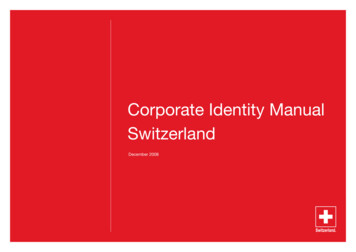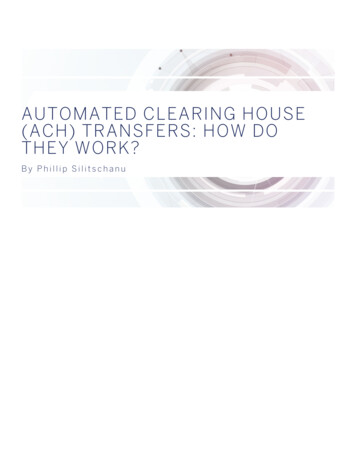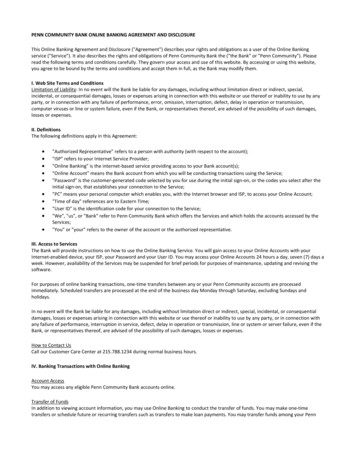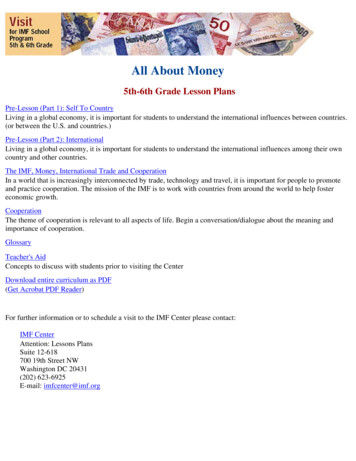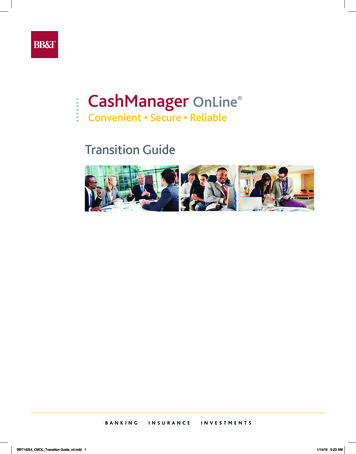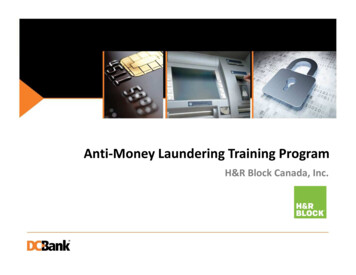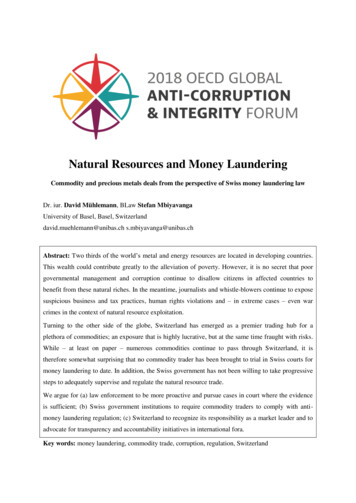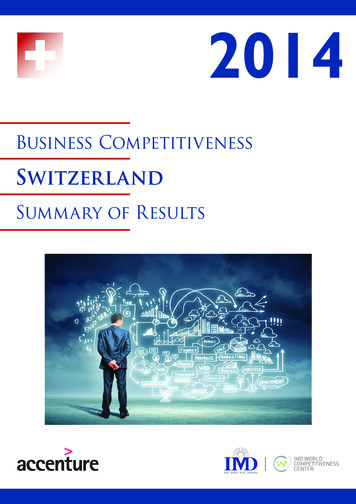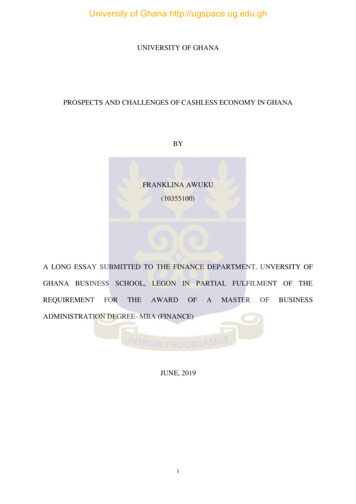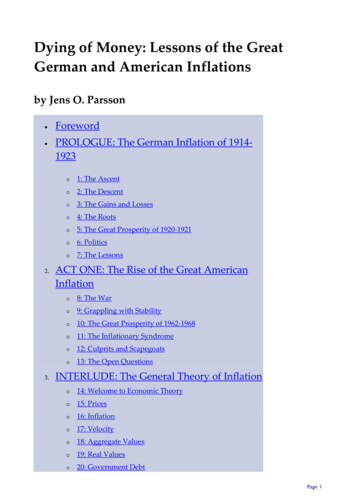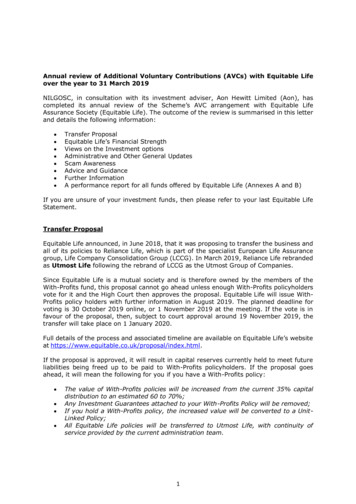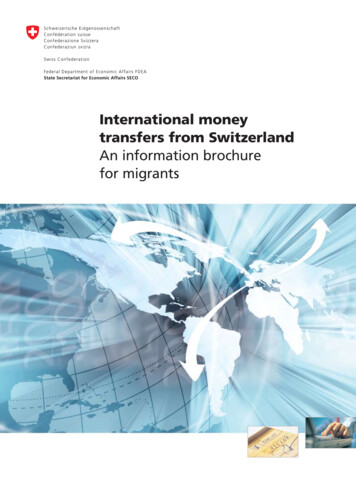
Transcription
International moneytransfers from SwitzerlandAn information brochurefor migrants
DisclaimerSECO assumes no liability for the correctness, accuracy, relevance, reliabilityor completeness of the information published.The information printed in this brochure and in the supplement represents thestate of knowledge as at 1 July 2008. Details on prices and services arefurnished by the service providers and could not be verified in all cases. Moreover, the information may have changed since publication of this brochure(and its supplement). Therefore, before using any of the services, the usershould check the current information from the service provider and should notrely solely upon the details given in this brochure (and the supplement). In allcases, the user should enquire about the service fee and exchange rate.In no event will the Federal Authorities be liable for any loss or damage ofa material or immaterial nature arising from use or non-use of publishedinformation.ContactState Secretariat for Economic Affairs SECOEconomic Cooperation and DevelopmentEffingerstrasse 1CH-3003 Berninfo@seco-cooperation.chTel. 41 (0)31 324 09 10www.seco-cooperation.chYear of publication: 2009This brochure is available in German, French, Italian, English,Albanian, Bosnian, Macedonian and Serbian.
ForewordRecent years have seen increased discussion on how best to use the opportunities posedby migration and mitigate the negative effects. A key topic in this respect is the transferof money, or remittances, by migrant workers to their country of origin. The value of suchremittances currently accounts for more than twice the total of official development aid.The objective must therefore be to cut down on the time and costs for remittances andstrengthen their contribution to development efforts.The State Secretariat for Economic Affairs SECO works towards both of these goals as part of itseconomic cooperation with developing and transition countries. In publishing this brochure, it contributesto greater transparency among the various operators and services on the Swiss market. In addition, inpromoting private sector development in transition and developing countries, it is helping to createattractive savings and investment opportunities on site. This encourages recipients to use the money notonly for spending but also, and increasingly, for productive investments, thereby contributing to growthand job creation in their own country.In addition to specific details on money transfer operators in Switzerland, including their services andprices, this brochure also provides general information on money transfers and financial services. Thiswill help users of such services to overcome knowledge barriers and make it easier for them to accessfinancial services.With this brochure, the State Secretariat for Economic Affairs SECO aims to provide you with a soliddecision-making basis for the next time you send money home. At the same time, we must stress thatyou should always check the price and conditions before making a transfer, as these can change veryquickly. By law, operators are obliged to display their prices and exchange rates, so make sure to ask tosee these.The future of the money transfer market is also of interest. We can expect to see some new productsthat make transfers even more efficient, such as the possibility of sending money by mobile phone. Interms of development policy, products designed specifically for migrants – combining money transferwith savings and investment opportunities – would be particularly welcome.Jean-Daniel GerberState SecretaryState Secretariat for Economic Affairs SECO3
Table of contents1. Overview: What are the options? 62. Banks 83. Post office: Swiss Post 114. Money transfer operators 125. Online payment systems 146. Glossary 16
1. Overview: What are the options?Do you want to send money from Switzerland toHowever, depending on the provider and theiryour family members, friends or acquaintances inoffering, the costs, transfer times and terms of useanother country? If so, there are a number of op-differ enormously. This brochure provides infor tions available to you. You can transfer the moneymation on the most important transfer possibilitieseither via a bank, the post office or a specialisedand outlines the advantages and disadvantagesmoney transfer firm. You can also use an onlineof each.payment system to send the money.A. Legislation* on price transparency in money transfersIn Switzerland, consumers must be informed in advance of the The prices and the associated services should be published incharges for banking and bank-like services, such as domestic andprice lists, catalogues, the Internet, etc. in an easily accessibleinternational payments and currency exchange. The followingand clearly legible manner. At banks, post offices, bureaux derules apply:change, money transfer firms, etc., the pricing information must For foreign exchange transactions at the counter, the exchangerates for buying and selling the major currencies must be posted.This must be updated daily, specifying that the actual ratesbe published or posted at the counter or wherever the customernormally is. It is not sufficient to merely state such informationorally.may differ and should be obtained from the counter. The feesAny breaches of these transparency rules may be reported to theincurred in buying/selling foreign currencies should be statedappropriate cantonal commercial police authorities.in a clear and transparent manner. For money transfer transactions, the transfer fees should bespecified.6* Ordinance of 11 December 1978 on the Notification of Prices
In the coloured boxes, you’ll find useful infor Please note that this brochure does not containmation concerning money transfers. Terms printedinformation on transfers to specific countries butin italics are explained in the glossary on pagemerely selects the most common transfer possi 16ff. In the supplement to this brochure, you willbilities and explains in general how these work.find the fees of various providers, expected transfer times and other important details at a glance.Note that banks and other businesses offeringbank-like services in Switzerland are legallyobliged to publish their prices (see Box A).Depending on the canton and your category ofresidence permit, you may also be able to deductyour money transfers for tax purposes (see Box B).B. Money transfers and tax deductionsMigrants with a „C” permit and naturalised citizens in Switzerlandfamily members who are partially or totally unfit for work or inare subject to normal tax assessment, i.e. like all natural personsneed of care. Note that the possibilities for deductions may differliving or residing in Switzerland, they must file a normal taxfrom one canton to another. In general, you will be asked to pro-return. The part of a migrant’s salary that is sent to his or hervide proof of money transfers made to the funded person abroadfamily in the country of origin can be taken into account withinas well as official certificates on their income situation and theirthe scope of social security deductions (DBG Art. 213). However,partial or total unfitness for work or need for care.this deduction only applies for maintenance payments forchildren who are of minor age or in vocational education and for7
2. BanksGeneral informationHow do I transfer moneyThere are over 300 banks in Switzerland. All ofabroad via a bank?these have a licence to operate from the SwissIn general, you can make international transfersFederal Banking Commission and are subjectin writing (letter or form) or via e-banking (seeto state regulation. To make payments abroad,Box E). Often it is also possible to submit yourbanks require you to have an account with them.order at the counter or by telephone, althoughOccasional customers, i.e. who do not have athese options generally cost more. To minimisebank account, are no longer accepted under thethe costs incurred in sending money, it is impor-anti-money laundering rules. If you already have atant to give the bank the following informationbank account in your home country and your bankwhen submitting your payment order, whetherhas a subsidiary or branch in Switzerland, you canby Internet, in writing or by phone:make money transfers to your home country in theform of domestic payments via the Swiss subsi diary or branch. If this is not the case and you planto remain for an extended period in Switzerland,Your name and address Your account number or IBAN(see Box D)you are advised to open an account with a Swiss The recipient’s name and addressbank. You will find all the necessary details for The recipient’s BIC and IBAN (see Box D)opening an account in Box C. Note that therecipient must also have a bank account.or account number The name and address of the recipient’s bank The destination country The currency The amount you wish to transfer The reason for paymentC. How do I open an account? Your chosen payment option, see p. 10Opening a bank account is normally a simple and straight forward process. Go to any bank of your choice and ask aboutthe various accounts they offer. If you want to send moneyabroad, your best option would be to open a salary or currentaccount. To open an account, you usually need to take alongyour passport, your residence permit (B, C, L, G, F, N) or refugeetravel document and proof of your address. In certain cases,the bank may also ask to see a copy of your employmentcontract or your work permit.D. What do IBAN and BIC mean?IBAN stands for International Bank Account Number andcontains details about the country, the financial institute andthe account number. The IBAN serves as a unique form of identification for a bank account. The BIC (Bank Identifier Code),also called the SWIFT code, is used for unique identificationof the bank. For all international payments from Switzerlandto a country in the EU or the EEA, the IBAN and BIC mustbe stated. If these are not given, the bank may charge asupplement.8
Please note that, for reasons of security and cost,How long does it take for the moneyyou must always give these details in full andto reach the recipient?correctly. If possible, the bank’s name must beFor international payments, banks and savingsgiven in an internationally spoken language, suchinstitutions have to work with banks in the recip-as English. Also, the recipient’s name must be theient’s country. Therefore, they often cannot say insame as that of the accountholder. If you are missingadvance exactly how long the transfer will take orany of the above details, ask the recipient or yourmuch it will cost in total. An exception is made forbank in Switzerland.SEPA payments (see Box F), where the bank canguarantee a maximum duration of three workingdays. Apart from this special form of payment,transfers usually take between two to five daysfor countries in Europe and seven or more daysE. What’s e-banking?for countries outside of Europe. To ensure thatE-banking stands for „electronic banking” and refers to bankpossible, take note of your bank’s acceptance cut-transactions conducted by electronic means. With e-banking,off times.the money reaches its destination as quickly asyou can make payments online from your home and checkyour account balance at any time. E-banking is the fastest andmost inexpensive way of making bank transfers within Europe.To be able to use e-banking, you will need, apart from a bankaccount, an e-banking contract with your bank, a suitableoperating system (usually Windows 2000, XP, Vista or MacintoshOS X), an Internet browser and Internet access. Make sure youobserve your bank’s security guidelines.F. What does SEPA mean?SEPA is the Single Euro Payments Area in existence sinceend-January 2008 where all payments are treated as domesticpayments. With SEPA, money transfers in euros betweenall countries of the EU, the EEA and Switzerland are faster(max. 3 business days) and cheaper (usually free). The countries covered by SEPA are Austria, Belgium, Bulgaria, Cyprus,Czech Republic, Denmark, Estonia, Finland, France, Germany,Greece, Hungary, Iceland, Ireland, Italy, Latvia, Liechtenstein,Lithuania, Luxembourg, Malta, Netherlands, Norway, Poland,Portugal, Rumania, Slovakia, Slovenia, Spain, Sweden, Switzerland and the UK.9
How much will I be chargedIn general, the default option Shared Costs isto transfer money via a bank?recommended. However, some banks also offer aAs the person submitting the order, you pay theflat-rate third-party fee. This means that, apartservice price charged by your bank for the transfer.from the service price, you pay a fixed amountDepending on which payment option you choose,that covers all third-party charges. This variantyou may also pay the fees charged by the recipi-makes sense if the flat-rate fee is lower than theent’s bank. These fees are called third-party charg-total third-party charges. In this case, if you choosees and are often not known in advance (except inthe Our Costs option and pay the flat-rate third-the case of SEPA payments). There are three op-party fee, you can minimise third-party chargestions available to you. With the default optionand make sure that the highest possible amountShared Costs (abbreviation: SHA), you pay onlyis ultimately paid to the recipient.the service fee charged by your bank. The thirdparty charges are borne by the recipient and de-Note, however, that some banks in the recipient’sducted from the amount received. With the optioncountry also charge an incoming fee for their cli-Our costs (abbreviation: OUR), you – as the per-ent’s incoming payments, in addition to third-partyson submitting the order – accept all of the costscharges.including the third-party charges. The recipientthus receives the full amount transferred by you.In general, it costs less to make fewer but largerThe third option is called Beneficiary (abbrevia-transfers abroad. For the precise fees of the indi-tion: BEN) and means that the recipientvidual banking providers, see the supplementaccepts all costs, which are deducted from the(p. 5-17).amount received. Thus, in this case, the personplacing the order does not have to pay anythingfor the service.Overview of the advantages and disadvantages of bank transfersAdvantagesDisadvantages Fast and reasonably priced with e-banking or standing order Recipient’s bank may charge high fees Transparent exchange rates based on market rates Often takes a long time to countries outside of the EU/EEA High level of security Bank account needed Additional financial services available, such as loans, Payment order at the counter or by phone only possiblemortgages or savings products10on business days
3. Post office: Swiss PostAt Swiss Post, domestic and international pay-As a special product, in collaboration with anments are processed by the financial instituteinter national money transfer operator, Post FinancePostFinance. In contrast to specialised moneyoffers the possibility of sending money online.transfer operators, PostFinance allows you toTo do this, you need to have an account withopen an account and use other financial servicesPost Finance. For the specific services offered bysuch as savings or pension provision products.Post Finance, see the supplement (p. 18-19).However, unlike at a bank, you can also pay transferamounts in cash at PostFinance.Overview of the advantages and disadvantages of post office transfersAdvantagesDisadvantages Cash payments possible Recipient’s bank may charge high fees High level of security Often takes a long time to countries outside of the EU/EEA Offers a specific product for migrantsor for the cash to be paid in the recipient’s country Additional financial services available,(except in the case of the special product)such as savings or pension provision products Closed on Sundays and outside of office hours11
4. Money transfer operatorsGeneral informationHow do I make a transferIn Switzerland it is also possible to send money byusing a money transfer operator?way of specialised money transfer operators. TheseYou don’t need a bank account to send moneyinclude the large international firms, which usuallywith a money transfer operator. The process isoperate together with sales partners known assimple and operates in the same manner with allagents. For example, in Switzerland these may beproviders. You pay your money in cash to thepublic service providers, travel agents, Internetagent (sales partner) or directly the firm itselfcafés or small shops, which offer money transfer(usually in Swiss francs) and fill in an accompanyingservices as an additional line of business. Thereform with your personal details and those of theare also many smaller firms offering a transferrecipient. For security reasons and to fulfil theservice, often serving certain specific countries only.identification requirements, the provider will askyou for a valid ID card. You also have to declareIn Switzerland, any person professionally offeringthe beneficial ownership of the money to be trans-services associated with money transfer must beferred. If necessary, the provider will also askmonitored by the Anti-Money Laundering Controlabout the origin and the purpose of the money toAuthority or by a self-regulating organisation autho be transferred (see Box G). Once your money hasrised by it.been transferred, you inform the recipient andgive him/her the information needed to pick upthe money (e.g. the reference number). In somecases, it is sufficient for the recipient to present avalid form of identification. Depending on the provider and the country, however, additionaldocumentation may be required. The money isG. ID requirementsand other obligationspaid out to the recipient in different ways: it mayIn an effort to help combat money laundering and the fundingby home delivery.of terrorist activities, providers of money transfers are legallyobliged to identify their customers, to check the beneficialownership of the money in question and, if necessary, makeother enquiries. While banks identify their customers via theaccount obligation, specialised money transfer firms requirea valid form of ID for the transfer, usually for both the senderand the recipient. Apart from a valid ID (passport, nationalidentity card, foreign resident’s permit), additional documentsmay sometimes also be required, such as proof of residence.12be paid in cash by an agent in that country, transferred to a bank account, or sometimes even sent
How long does a transfer take?How much does a transfer cost?As most of the specialised money transfer ope The fees charged by the individual providersrators have their own network, it usually takes(though not by agents of the same provider) mayjust a few minutes for the money to reach thevary greatly. In general, the fees charged by allrecipient. If the money is delivered to the recipi-providers depend on the amount of money beingent’s home or transferred to a bank account, thetransferred. For prices and conditions, see thetransfer takes longer to complete.supplement (p. 20-23). Note, also, that in additionto the transfer fees, specialised money transferoperators also earn income on currency exchange,using higher exchange rates. Not all providerspublish their fees and exchange rates, eventhough they are legally obliged to do so (seeBox A). Make sure to ask to see them.Overview of the advantages and disadvantages of money transfer operatorsAdvantagesDisadvantages Fast Generally expensive for transfers of small sums of money High level of security Exchange rates higher than market rates Wide reach No other financial services offered No bank account needed Also open on Sundays and outside of normal office hours13
5. Online payment systemsGeneral informationHow do I transfer moneyYou can also send money from Switzerland usingusing an online payment system?online payment systems. These payment systemsAlthough the individual online payment systemsare offered by various financial institutes foroperate more or less similarly, they may differ inelectronic money. With most providers, you willcertain important points. For instance, one impor-need a credit card or at least a bank accounttant difference is whether the transfer is made viaas well as access to the Internet. The recipienta customer account or using a prepaid card:should also have a bank account and Internetaccess, even if this is not necessary in certain cases.The examples of online payment systems listedin the supplement are among the best-knowninternational firms in the business. They all use anacknowledged secure encryption technology toprotect your financial details and prevent thesebeing shown to the recipient. The companies inquestion are regulated or licensed by a specialiststate or non-state body. See also the provider’swebsite to find out about the security measuresthey use and recommend. Transferring money with a customer accountWith an online payment system that uses customeraccounts, both the sender and the recipient areregistered with the provider. They each give theprovider their personal details and are assigned acustomer account in the currency of their choice.The sender can deposit money on his/her customeraccount by means of a bank transfer or a creditcard; the money thus transferred is then electro nically credited to his/her customer account. Thesender can then send the electronic money to therecipient’s customer account. Usually, all that isneeded to do so is the recipient’s e-mail address.The recipient can then have the electronic moneytransferred to his/her bank account or credit card orpaid out by cheque. Transferring money with prepaid cardsWith online payment systems that use prepaidH. ATMsThere are over a million ATMs worldwide in more than 120countries. Most of these are located in large towns; thereare fewer in smaller towns and villages and throughout theMiddle East and Africa.As a rule, ATMs are very easy to use: you insert your paymentcard (prepaid card, debit or credit card) and select thelanguage of your choice. Type in your PIN code and then followthe instructions on the screen to get the cash amount yourequire (paid out in the local currency) and the transactionreceipt.14cards, the recipient does not have to have acustomer account and therefore an Internetconnection. The money is transferred as follows:The sender opens a customer account with theprovider to which it transfers money (electronically)by credit card. The recipient then receives aprepaid card with the corresponding PIN code,which it can use to withdraw the transferredmoney from an ATM (see Box H) or make cashlesspayments.
How long does the transfer take?How much does it costIf you transfer money with your credit card, yourto use online payment systems?customer account is usually topped up straightWith certain providers and for certain countries,away. If you make the transfer via a bank pay-money transfers via an online payment systemment, it can take up to three business days orcan be very inexpensive. The transfer fees aremore to reach your account. Then you have tomade up of the account management fees, thewait another two to seven business days beforefees for paying the money into the customerthe money is credited to the recipient. With onlineaccount, the sending and receipt of the money,payment systems using prepaid cards, a recipientthe fees for paying out in the recipient’s countrywho already has a prepaid card can withdraw theand for foreign exchange. Some online paymentcash from an ATM as soon as the payment hassystems have an account with the sender’s andbeen made.recipient’s bank. In this case, the deposit andwithdrawal of cash on the customer account istreated as a domestic transfer, which incurs verylow charges. If the provider’s bank does not workwith the sender’s or recipient’s bank, highthird-party charges may apply in certain circumstances. For an overview of the fees charged, seethe supplement (p. 24-27).Overview of the advantages and disadvantages of online payment systemsAdvantagesDisadvantages Inexpensive, depending on the provider Additional fees may be chargedand the recipient’s country Easy to use(e.g. third-party fees by the recipient’s bank) The transfer takes a long time if paymentsare to be made to the recipient’s bank account Credit card and/or bank account required Internet access usually needed at both the sender’s andrecipient’s end (except for systems using prepaid cards)15
6. GlossaryAcceptance cut-off time The acceptance cut-off time is the deadline for submitting a payment orderto a bank for the transfer to be made at the desired time.Beneficiary (BEN)A payment option in bank transfers where the recipient assumes all third-party charges.Customer accountUnlike a bank account, a customer account with an online payment systemwith an online payment is not associated with a bank and has only electronic money deposited in it.systemEEAThe European Economic Area (EEA) comprises the 27 EU member states plusthree member states of the European Free Trade association (EFTA) – Iceland,Liechtenstein, Norway. The expanded union serves to create a large Europeandomestic market. Switzerland is not in the EEA.Electronic moneyElectronic money is monetary value stored electronically, e.g. on the Internet.It is usually credited virtually in return for payment of the correspondingamount by credit card or a bank deposit. The monetary value stored is alsoaccepted by other companies as a means of payment.EUThe European Union (EU) is a union of currently 27 European states sharingcommon economic and political goals, including the free movement of persons, goods, services and capital. The current member states of the EuropeanUnion are: Austria, Belgium, Bulgaria, Cyprus, Czech Republic, Denmark,Estonia, Finland, France, Germany, Greece, Hungary, Ireland, Italy, Latvia,Lithuania, Luxembourg, Malta, Netherlands, Poland, Portugal, Rumania,Slovakia, Slovenia, Spain, Sweden, UK (as at August 2008).Flat-rate third-party feeA flat-rate fee paid by the sender when making international transfers inaddition to the price for the transfer itself. The flat-rate fee covers all third-party charges.16
OnlineTransactions made via the Internet, e.g. money payments via e-banking orusing online payment systems.Online payment systems Online payment systems are firms that offer international payments on theInternet and conduct these using electronic money.Our Costs (OUR)A payment option in bank transfers where the sender assumes all third-party charges.PIN(-Code)PIN stands for Personal Identification Number and is a secret number bywhich a person can identify him/herself to a machine or system. As a rule, thePIN code is known only to that person.Prepaid cardA prepaid card is a payment card that is independent of a bank account andcan thus also be used by people who do not have a bank account. The cardholder can only ever dispose of the amount that is actually on the card.RecipientThe recipient is the person who receives the money in the case of a transfer.SenderThe sender (also known as „remitter”) is the person who transfers the money.Shared Costs (SHA)A payment option for bank transfers whereby the sender and the recipienteach pay the respective fees charged by their own bank.Third-party chargesThird-party charges are the fees deducted by the recipient’s bank or postoffice in addition to the international transfer fee. Depending on thepayment option chosen, the third-party charges are payable by the personplacing the order (OUR) or the recipient (BEN) or shared by both (SHA).17
Options available at a glance
ContactState Secretariat for Economic Affairs SECOEconomic Cooperation and DevelopmentEffingerstrasse 1CH-3003 Berninfo@seco-cooperation.chTel. 41 (0)31 324 09 10www.seco-cooperation.chYear of publication: 2009This supplement is available in German, French, Italian, English,Albanian, Bosnian, Macedonian and Serbian.
DisclaimerSECO assumes no liability for the correctness,from the service provider and should notaccuracy, relevance, reliability or completenessrely solely upon the details given in thisof the information published.supplement. In all cases, the user shouldThe information printed in this brochure andin the supplement represents the state ofenquire about the service fee and exchangerate.knowledge as at 1 July 2008. Details on pricesIn no event will the Federal Authoritiesand services are furnished by the servicebe liable for any loss or damage of a materialproviders and could not be verified in allor immaterial nature arising from use orcases. Moreover, the information may havenon-use of published information.changed since publication of the supplement.Therefore, before using any of the services,the user should check the current information
Options available at a glanceThis supplement gives you an overview of the prices, timing andLayoutother conditions for the various ways of sending money abroad fromThe supplement is arranged alphabetically by type of transfer.Switzerland. Here, you will find details about the different offers,to help you decide in advance which one to use. However, beforechoosing any of these services, you should always ask the providerfor their latest terms and conditions.PricesNote that, unless otherwise stated, all prices are given in Swiss francs(CHF).Reference date for informationThis information is applicable as at 1 July 2008. Any subsequentchanges have not been taken into account. The supplement will beupdated at regular intervals.Completeness of informationDespite all attempts to include as many money transfer providers aspossible, the supplement does not claim to be exhaustive, given thedisparate nature of the money transfer market. Any providers notlisted should contact the publisher.4
BanksPages 6-17 list banks in Switzerland from which you can sendTransfer timesmoney abroad. The fo
IBAN stands for International Bank Account Number and contains details about the country, the financial institute and the account number. The IBAN serves as a unique form of iden-tification for a bank account. The BIC (Bank Identifier Code), also called the SWIFT code, is used for unique identification of the bank.
